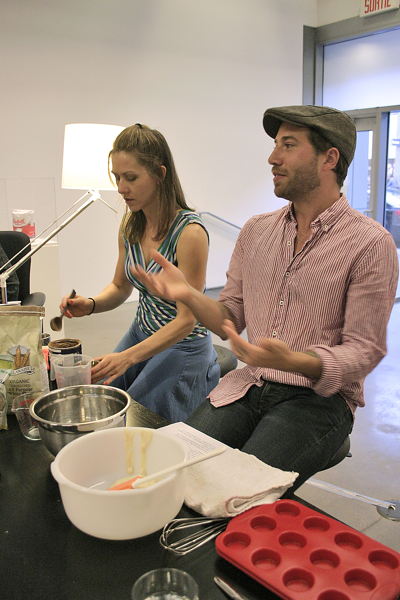Refine Arts

You would expect to find sugar in a galette, not a gallery.
Almost by accident, artist Shelley Miller has refined sugar’s potential as an artistic medium able to mimic other substances, along with its symbolic evocation of domesticity, consumption and global exchange.
This summer, almost a decade after she graduated from the MFA Open Media Program, the FOFA Gallery featured her work in a solo show.
The FOFA show emphasized Miller's unusual medium with a series of educational events. Young people from the Tyndale St. George's Community Centre were shown Miller's work and then produced their own designs in the courtyard outside of the Gallery. "Their program is really exciting and interesting," said Miller. "I love that they were able to use the exhibition as a springboard, and it was no longer just about me."

Miller did participate in a "Meet and Treat" with Research Chair Satoshi Ikeda and chef Blake McKay. The discussion started around a table laden with ingredients for a batch of vegan cupcakes. "We were all really interested in each other's work," said Miller of the discussion. "We started talking about where our food comes from and how it reaches us."
As an art student in Calgary, Miller was always on the lookout for inexpensive, original materials. A friend who worked in a bakery called her to let her know that a huge tub of icing couldn't be used because it had been improperly prepared.
"I started working with sugar as a type of decoration, referencing other types of decoration," said Miller. Over time, she developed the material's relationship to female labour and to decoration. Miller pressed, sculpted, stacked and squeezed fondant, icing and sugar pastes into colorful works on gender relations, weddings and a variety of domestic themes.
After graduating from Concordia in 2001, Miller travelled to India. Her audience there raised the wasteful aspect of using an edible material in artistic production. The challenge got Miller thinking of the disposable, non-essential role sugar plays in North American diets.
"So I did a series of cake sculptures on themes of luxury and excess -- casinos, sports cars, designer handbags, guilty shopping -- the cycle of binging and purging," said Miller.

A trip to Brazil (the world's largest sugar exporter) in 2004 underscored sugar's importance as an international commodity. The movement of goods (and labour) on a global scale led to the development of Cargo, a site-specific work displayed near the Darling Foundry in Griffintown.
Designed in fondant and attached to an external wall with icing, the large-scale image (over 5 x 11 feet) was presented in the form of a traditional ceramic azulejo.
"Cargo refers to sugar and slavery. I tried to bring Montreal and Canada back into the triangle of the sugar trade," said Miller. Miller ensures that her work remains site-specific, a consideration in the public art project she is currently preparing for the Centre d'accueil Marcelle-Ferron in Brossard.
Photos of Cargo's existence were taken to document its (surprisingly brief) presence, "It didn't last long. It hadn't rained for weeks and then it rained the whole week."
One of the dozens of photos Miller took replaced the installation for the Mois de la Photo. That image earned the people's choice award during the 2009 edition of the event. The work will remain up until 2013.
An interactive version of Cargo was installed in the FOFA Gallery, allowing the viewer to manipulate the individual tiles "I wanted to recreate the sense of movement and play," Miller said, referring to the ephemeral nature of the original work.
In addition to the Brossard piece, Miller is working on a collaborative project geared toward youth to take place at Toronto's Harbourfront next summer.
And after a decade of working with sugar, she's not quite ready to cut it out of her diet. "I stopped saying I'm done with it. Every time I do, there are always a few things to explore."